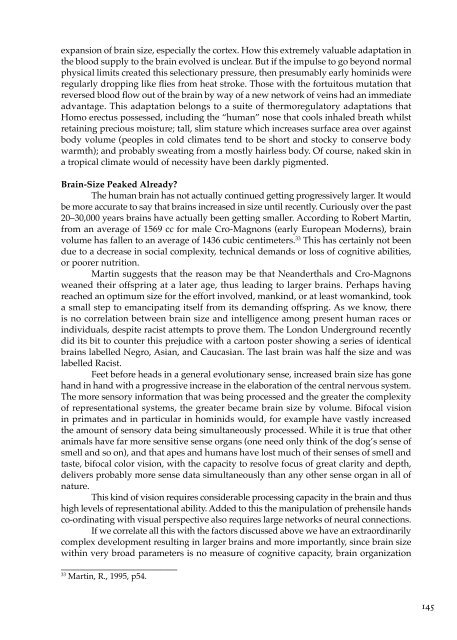The Spirit in Human Evolution - Waldorf Research Institute
The Spirit in Human Evolution - Waldorf Research Institute
The Spirit in Human Evolution - Waldorf Research Institute
Create successful ePaper yourself
Turn your PDF publications into a flip-book with our unique Google optimized e-Paper software.
expansion of bra<strong>in</strong> size, especially the cortex. How this extremely valuable adaptation <strong>in</strong><br />
the blood supply to the bra<strong>in</strong> evolved is unclear. But if the impulse to go beyond normal<br />
physical limits created this selectionary pressure, then presumably early hom<strong>in</strong>ids were<br />
regularly dropp<strong>in</strong>g like flies from heat stroke. Those with the fortuitous mutation that<br />
reversed blood flow out of the bra<strong>in</strong> by way of a new network of ve<strong>in</strong>s had an immediate<br />
advantage. This adaptation belongs to a suite of thermoregulatory adaptations that<br />
Homo erectus possessed, <strong>in</strong>clud<strong>in</strong>g the “human” nose that cools <strong>in</strong>haled breath whilst<br />
reta<strong>in</strong><strong>in</strong>g precious moisture; tall, slim stature which <strong>in</strong>creases surface area over aga<strong>in</strong>st<br />
body volume (peoples <strong>in</strong> cold climates tend to be short and stocky to conserve body<br />
warmth); and probably sweat<strong>in</strong>g from a mostly hairless body. Of course, naked sk<strong>in</strong> <strong>in</strong><br />
a tropical climate would of necessity have been darkly pigmented.<br />
Bra<strong>in</strong>-Size Peaked Already?<br />
<strong>The</strong> human bra<strong>in</strong> has not actually cont<strong>in</strong>ued gett<strong>in</strong>g progressively larger. It would<br />
be more accurate to say that bra<strong>in</strong>s <strong>in</strong>creased <strong>in</strong> size until recently. Curiously over the past<br />
20–30,000 years bra<strong>in</strong>s have actually been gett<strong>in</strong>g smaller. Accord<strong>in</strong>g to Robert Mart<strong>in</strong>,<br />
from an average of 1569 cc for male Cro-Magnons (early European Moderns), bra<strong>in</strong><br />
volume has fallen to an average of 1436 cubic centimeters. 33 This has certa<strong>in</strong>ly not been<br />
due to a decrease <strong>in</strong> social complexity, technical demands or loss of cognitive abilities,<br />
or poorer nutrition.<br />
Mart<strong>in</strong> suggests that the reason may be that Neanderthals and Cro-Magnons<br />
weaned their offspr<strong>in</strong>g at a later age, thus lead<strong>in</strong>g to larger bra<strong>in</strong>s. Perhaps hav<strong>in</strong>g<br />
reached an optimum size for the effort <strong>in</strong>volved, mank<strong>in</strong>d, or at least womank<strong>in</strong>d, took<br />
a small step to emancipat<strong>in</strong>g itself from its demand<strong>in</strong>g offspr<strong>in</strong>g. As we know, there<br />
is no correlation between bra<strong>in</strong> size and <strong>in</strong>telligence among present human races or<br />
<strong>in</strong>dividuals, despite racist attempts to prove them. <strong>The</strong> London Underground recently<br />
did its bit to counter this prejudice with a cartoon poster show<strong>in</strong>g a series of identical<br />
bra<strong>in</strong>s labelled Negro, Asian, and Caucasian. <strong>The</strong> last bra<strong>in</strong> was half the size and was<br />
labelled Racist.<br />
Feet before heads <strong>in</strong> a general evolutionary sense, <strong>in</strong>creased bra<strong>in</strong> size has gone<br />
hand <strong>in</strong> hand with a progressive <strong>in</strong>crease <strong>in</strong> the elaboration of the central nervous system.<br />
<strong>The</strong> more sensory <strong>in</strong>formation that was be<strong>in</strong>g processed and the greater the complexity<br />
of representational systems, the greater became bra<strong>in</strong> size by volume. Bifocal vision<br />
<strong>in</strong> primates and <strong>in</strong> particular <strong>in</strong> hom<strong>in</strong>ids would, for example have vastly <strong>in</strong>creased<br />
the amount of sensory data be<strong>in</strong>g simultaneously processed. While it is true that other<br />
animals have far more sensitive sense organs (one need only th<strong>in</strong>k of the dog’s sense of<br />
smell and so on), and that apes and humans have lost much of their senses of smell and<br />
taste, bifocal color vision, with the capacity to resolve focus of great clarity and depth,<br />
delivers probably more sense data simultaneously than any other sense organ <strong>in</strong> all of<br />
nature.<br />
This k<strong>in</strong>d of vision requires considerable process<strong>in</strong>g capacity <strong>in</strong> the bra<strong>in</strong> and thus<br />
high levels of representational ability. Added to this the manipulation of prehensile hands<br />
co-ord<strong>in</strong>at<strong>in</strong>g with visual perspective also requires large networks of neural connections.<br />
If we correlate all this with the factors discussed above we have an extraord<strong>in</strong>arily<br />
complex development result<strong>in</strong>g <strong>in</strong> larger bra<strong>in</strong>s and more importantly, s<strong>in</strong>ce bra<strong>in</strong> size<br />
with<strong>in</strong> very broad parameters is no measure of cognitive capacity, bra<strong>in</strong> organization<br />
_________________________<br />
33<br />
Mart<strong>in</strong>, R., 1995, p54.<br />
145
















